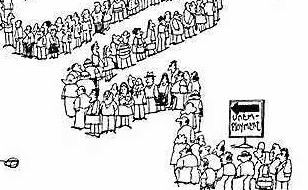The Turkish Statistical Institute (TÜİK) has published its comparison of data from November 2008 with the same month in the previous year. According to the data, the number of unemployed rose by 645,000 people, leading to a total of 2 million 995 thousand unemployed.
More young people unemployed
Unemployment among the young has risen from 20 percent to 23.9 percent. Both in cities and rural areas, total unemployment has risen by 2.2 percent, to 14.2 percent in the cities, and 9.3 in rural areas.
As economicst Mustafa Sönmez has pointed out in previous bianet articles, TÜİK does not count those not actively seeking work as unemployed, which means that the real rate of unemployment is higher.
Unemployment high in service industry
According to the TÜİK statistics,
- 72.6 percent of the unemployed are male
- 59.4 percent have no high school education
- 26.6 percent have been looking for work for a year or longer. Many of them (29.8) use friends and relations in this process.
- 86.5 percent (2 million 592 people) of the unemployed have previously been employed
- Of those unemployed who have worked before, 46.7 percent worked in the service sector, 25 percent in industry, 18.8 percent in construction work, and 9.5 percent in agriculture.
Only one in four women works outside the home
Again, according to TÜİK:
- 73.5 percent of the employed are male
- 59.5 percent work as paid employees, 27.5 are self-employed or employers, 13 percent are unpaid family workers
- 59.5 percent work in small work places that employ between 1 and 9 people
- 3.1 percent have another job to supplement their income. 4.3 percent are looking to change their jobs or to find an additional job.
Unfortunately, 44.5 percent of those working are not registered with any social security institution. Although there is a slight decline in this rate compared to last year, there is still evidence of much labour without insurance. In the agricultural sector, this is particularly striking; nine out of ten workers have no social security.
Only one in four women works, while 71 percent of males work. As education levels rise, this inequality becomes less marked; 71 percent of female and 89 percent of male university graduates work. (EÜ/AG)









